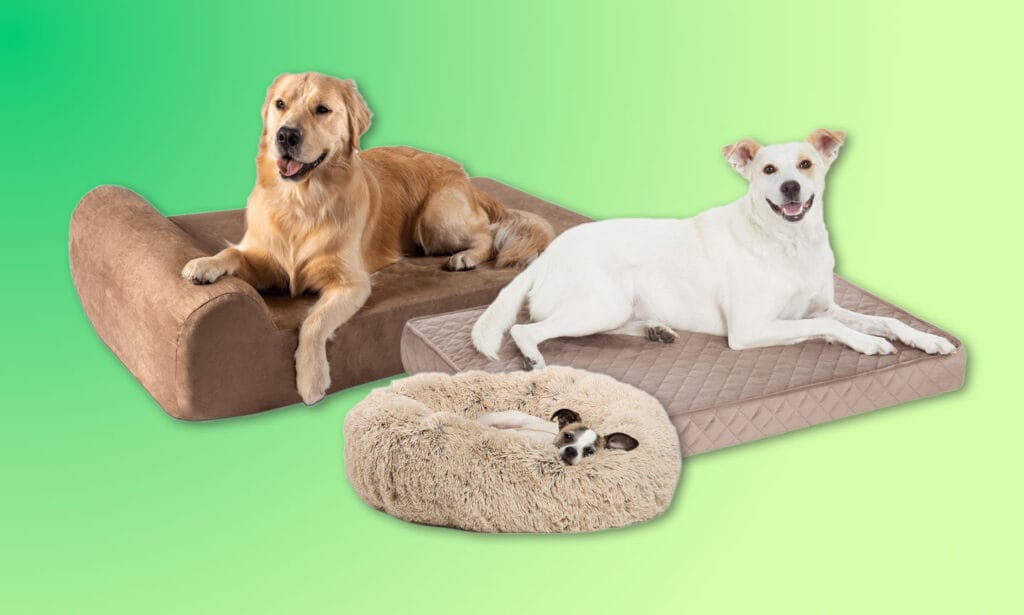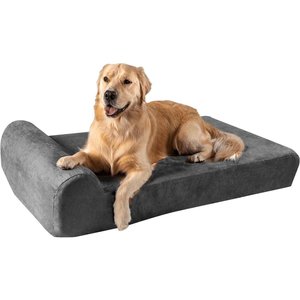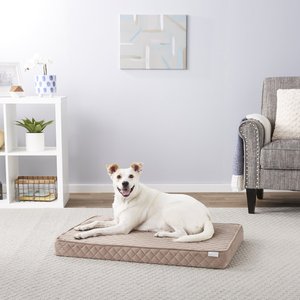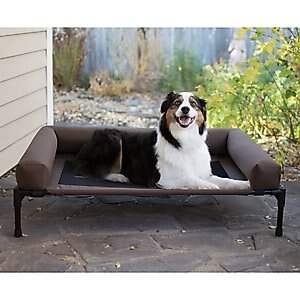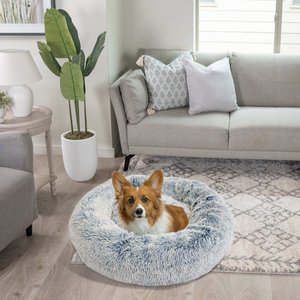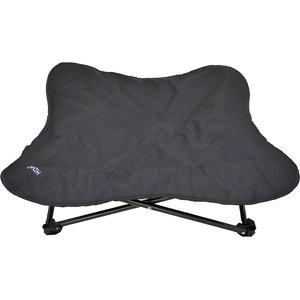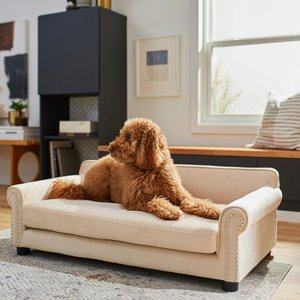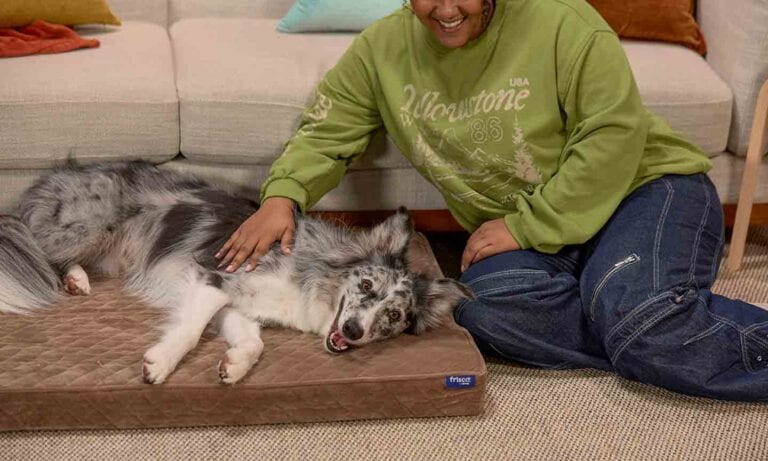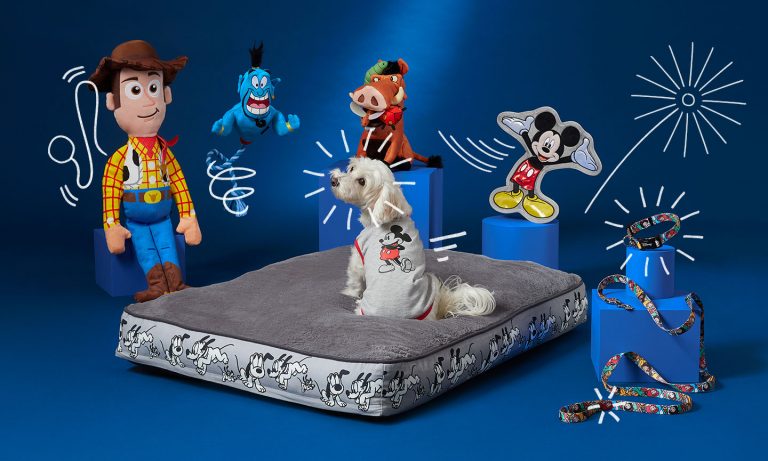Humans spend about a third of our lives sleeping, which is why choosing the right mattress is such an important decision. Dogs sleep a lot too—12–20 hours, depending on their age—and purchasing a dog bed is an equally important decision.
“We already know that good quality sleep is critical for human physical and mental well-being. The same goes for our dogs,” says Sarah Wooten, DVM, CVJ, a small animal veterinarian based in the Denver, Colorado, metro area.
Dogs need quality sleep to restore and repair their bodies. Providing a supportive sleeping surface where your dog enjoys sleeping can make all the difference.
“The quality of the bed can determine the quality of sleep and rest,” Dr. Wooten says.
To help you find the best bed for your dog, we tested 25 of Chewy’s top-rated dog beds in real-world conditions. We rated each bed on the following attributes: function, durability, ease of cleaning, value, and style.
The beds on this list are considered supportive, sturdy, stylish, and worth the spend.
-
1
Best Dog Bed for Large DogsBig Barker 7" Headrest Orthopedic Dog Bed with Removable Cover $290 on ChewyFREE 1-3 day shipping$290 on ChewyFREE 1-3 day shipping
-
2
Best Orthopedic Dog BedFrisco Quilted Orthopedic Pillow Lounger Cat & Dog Bed with Removable Cover $33 on Chewy
-
3
$152 on ChewyFREE 1-3 day shipping
-
4
Best Cooling Dog BedFurHaven Velvet Waves Perfect Comfort Cooling Gel Dog Bed with Removable Cover $95 on ChewyFREE 1-3 day shipping$95 on ChewyFREE 1-3 day shipping
-
5
Best Elevated Dog BedK&H Pet Products Original Bolster Pet Cot Elevated Dog Bed $78 on ChewyFREE 1-3 day shipping$78 on ChewyFREE 1-3 day shipping
Best Dog Bed for Large Dogs
The Big Barker bed earned big accolades from our tester, Mary Schwager, due to its size, support, and sturdiness.
Designed specifically to accommodate large breed dogs, the Big Barker comes in three big sizes: Large (48’ ’x 30’’ x 7’’); XL (52” x 36” x 7”); and Giant (60” x 48” x 7”). Schwager found the Large size bed to be a great fit for her two Labrador Retrievers, Macy and Jackson, to sleep on individually.
“I've tried out a lot of dog beds after 25 years of having Labradors as members of our family, and this one is a great find,” she says. “It's a perfect bed for medium to large-size dogs.”
Though she would prefer a bolster on both sides of the bed, Schwager was especially impressed with the bed’s thickness and firmness.
"When my dogs sleep on it, they're several inches off the ground, and the bed doesn't pancake down,” she says.
Handmade in the USA, the Big Barker offers three layers of support, including an orthopedic foam layer certified by CertiPUR-US to meet its standards for durability, chemical content, and indoor air quality. It even comes with a 10-year "No Flatten" warranty, ensuring the foam will retain at least 90% of its original shape and support over time.
On top of that, it was easy to spot-clean, and the removeable cover held up well in the wash.
Though even the smallest size costs well over $200 and the largest size can run over $500, Schwager says it’s worth the investment for large dogs and/or dogs with arthritis. (A University of Pennsylvania study found that the bed helped reduce joint pain and improve mobility in large dogs with arthritis.)
“This bed is the real deal,” she says. “It looks and performs exactly as advertised. Though it's a bit on the higher-priced scale of beds, if you have a Labrador, Golden Retriever or a larger-sized dog they will appreciate it.”
Things To Consider:
• Available in several large sizes to accommodate big dogs
• Made with CertiPUR-US certified orthopedic foam
• Guaranteed to retain the majority of its shape and support
• Removable, machine-washable cover
• Four color options
• One headrest
• High price point
-
Helped my 9 year old Pitt mix
My dog was struggling to get up from his bed and I was worried how much his arthritis had been affecting him. Since getting the bed about a month ago, he hasn’t struggled nearly as much to get up and down, and his actually moving better overall. Worth the money!
-
Be patient
We have a 75 lb senior dog with bad arthritis and picky about food and his comfy spots. When we got this bed, I was worried initially about how high it is (requires him to step up and then walk/move on memory foam. He did it immediately but seemed to hesitant to get up and get out (eventually did) but then didn't get in it for a few days. We thought we might have to return it but he tried it again and slowly kept using it. He sleeps in it every night now and he seems to sleep better (doesn't get up and change spots or go outside all night long like he used to). Old dog, new trick, but seems to be a success. He likes the built-in pillow...
-
My dogs love their beds!
My first order of this bed was great. My Rottweiler loves it. Therefore, I ordered another for her brother and he loves it as well!
Best Orthopedic Dog Bed
Support is key when it comes to orthopedic dog beds. This one earned top marks from our tester, Chewy Managing Editor Bre South, for the firmness of its solid memory foam cushion. Not only did it provide maximum support for her dog, Ezra, but the large size (35” x 23”) provided plenty of sleeping surface for the black Lab mix.
“So many beds claim to be ortho and yet they have no support,” South says. “This bed was super firm and soft and was large enough for her to lay across it.”
The height of the bed was another pro. At 3 inches tall, it’s high enough to keep Ezra off the cold hardwood floor, but low enough that the 14-year-old senior dog could easily climb onto it.
“Senior pups can struggle getting on and off beds, and this one she had ease moving on and off it,” South says.
The bed is completely flat and would fit well in a crate if needed, but it doesn’t offer bolsters or headrests, which South notes may not be ideal for some dogs.
“It would have been nice if the bed had a bolster to it so her head could be propped up, but I have a senior pillow for her that serves this purpose,” South says. “For someone looking for the extra head support, they won't find it on this one.”
During the testing period, South spot cleaned the bed, removed hair with a lint brush and vacuum, and machine washed the removable cover. It held up well to all, and South especially appreciated the zippers on two sides which made it easy to remove the cover and put back on.
With a price point well under $100 even for the largest-size bed, South believes it to be an excellent value.
“I often spend upwards of $100 to get a good bed for a large dog,” she says. “This is extremely affordable for someone looking for a great quality ortho dog bed, no matter if they want to place it in a crate or just have it as a living room lounge option.”
Things To Consider:
• Solid memory foam cushion provides optimal support
• Available in a range of sizes from S–2XL
• 3-inch height keeps dogs off the floor yet makes the bed easy to access
• No bolster or headrest
• Removable, machine-washable cover
• Three color options
-
It is the only crate pad my dog has not chewed up.
I put her old slightly chewed up pad on top of it. So far she has not damaged it with her chewing. It looks like she finds it to be comfy.
-
Spoo loved this
Attractive velvet cover, nice thick cushion: nice/looking enough to be out in the living room if the colors work.
-
Jack loves his Crate now
Jack is not put in the crate except for when other people are around. With his new cushion, he chooses to sleep in his crate most every night-he loves it!
Best Dog Bed for Chewers
Chewing is a natural dog behavior, but sometimes it can be destructive. Part of putting an end to destructive chewing involves dog proofing the home, and that may mean getting an indestructible dog bed, or something close to it.
We put such beds to the test with Cami, a 1.5-year-old puppy, who her mom describes as a super chewer. She’s chewed up one of her dog beds before and has a special penchant for chewing care tags off of blankets, pillows, and other things.
The Casper Dog Bed stood up to the challenge. Designed with durability in mind, it features two layers of foam for support, four bolsters (a favorite of Cami’s), and a removable cover made from olefin, which is a synthetic material known for its strength.
Heavy-duty zippers keep the cover in place—and keep out of sight. Sewn-in pockets hide the zippers so they won't scratch your floor—or tempt curious chewers.
“Apparently, the type of fabric alone deterred Cami. She never tried to chew it,” says her mom and longtime pet editor Marylou Zarbock.
The fabric also withstood Cami’s nails, and was easy to clean, whether by spot cleaning or tossing in the washing machine (though the cover can be a challenge to get back on the bed after drying). Zarbock even poured some orange soda onto the bed as a test and was happy to see that the liquid did not penetrate through to the foam core.
Ranging in price from around $100 to over $200, it’s not a cheap dog bed by any means, but it’s well-made and Zarbock suspects it’ll last a long time.
“The quality of craftmanship on the Casper bed is impressive,” she says. “All materials look and feel superior, and it’s evident that careful thought was put into every element of the design‚ even down to hiding the zippers.”
Things To Consider:
• Two layers of foam (memory foam and polyurethane support foam)
• Synthetic material cover designed for durability
• Four bolsters
• Removable, machine-washable cover
• Available in sizes Small, Medium, and Large
• Three color options
-
My dogs all prefer this bed!
I originally bought this bed about 6 years ago. It has held up amazingly! No tears, or foam breakdown. It washes very easily in the machine. My dogs all love this bed. Give me the choice, they choose this. If someone is already in it, they wait around until it's available. So I finally decided to buy another. Best decision ever!
-
Great quality, easy to put together, soft but firm
I have two Casper dog beds for my pup. I want to set her up to have a healthy life, so I chose this bed. She LOVES it. She's an energetic gal, but has no problem laying on her Casper bed for hours while I work from home.
-
Well made orthopedic bed for senior dog
He loves the support he gets for his old joints. Even I tried it out and it is very comfortable!
Best Cooling Dog Bed
If anyone can appreciate a cooling dog bed, it’s Chewy Senior Editor Kristine Cannon, who lives in the warm and sunny Phoenix area. She found the FurHaven bed to be both effective at cooling and a comfy place for her 3-year-old pooch, Odesza, to rest her head.
The soft velvet and faux-fur bed features a medical-grade foam core that is topped with gel-infused memory foam, which helps absorb body heat and cool the sleeping surface down by 1 or 2 degrees.
To test the bed, she placed it outdoors—no assembly required—in the sunniest part of the yard where Odesza likes to sunbathe and take her afternoon naps. Cannon notes the bed was cool to the touch, and Odesza took to it immediately.
While there are other types of cooling beds on the market, this one was a winner because it most resembles Odesza’s other beds.
The bolsters on all four sides were another big plus, adding extra comfort.
“This feature‚ along with the plush, soft faux-fur fabric‚ mimics her other favorite dog beds, which is probably why she gravitated to this cooling bed and was quick to use it,” she says.
The bed held up well outdoors, even though it is not designed specifically for the outdoors, with no discoloration or wear and tear. While it does tend to trap fur and dirt, Cannon says it’s easy to clean thanks to the zippered cover, which is easy to remove and toss in the washing machine.
Colors are limited but neutral. And while the price is higher than some other types of cooling beds (this one will run you anywhere from around $60 to close to $200, depending on the size), Cannon thinks it's worth the additional cost due to its extra features (foam padding, faux-fur fabric, and bolstered sides).
“This bed is great for dogs who prefer bolster beds and need a comfy place to cool off on hot days,” she says. “Because of the bed's orthopedic feature, this is also great for dogs who need extra support, including dogs who just had surgery and older dogs with joint pain.”
Things To Consider:
• Medical-grade foam core
• Gel-infused foam layer for cooling
• Soft exterior with bolsters on all four sides
• Available in sizes Medium–Jumbo Plus
• Removable, machine-washable cover
• Three color options
-
Sheltie Approved
Abby loves this bed. I went by the sizing chart provided and got the medium. (She’s 28lb and 14.5 inches tall). I would recommend sizing one up if your dog likes to spread out.
-
My dog loves this bed
I have an extremely large Rottweiler and ordered the Jumbo Plus. It’s the first bed that actually gave him enough room to stretch out. It’s supportive enough to absorb his weight without being so firm that it’s not comfortable. The bolsters around 3 sides are nice, and he uses them as pillows. We have one on each side of our bed and one in the living room. We replace one every 8 months because even the best beds lose their support when they sit on the ground. Best investment to prevent pain as big dogs get older.
-
Dog Can't Stay Out of It!
This is the best dog bed I've had for my pup, she loves it! A friend recommended it to me and we are glad we followed through and purchased it.
Best Elevated Dog Bed
Elevated beds come in a variety of styles, from luxury throne-type beds to simple cots. This cot-style bed won over our tester, professional dog trainer Maria Christina Schultz, due to its comfort, cooling ability, portability, and ease of cleaning.
Schultz tested the bed for two weeks with her two Australian Shepherds, Bodie and Willow. Neither had used a cot-style bed before so it did take some time for them to get acclimated, but once they did it quickly became a go-to bed.
“The raised design seemed to appeal to them. Both dogs liked having a more defined, elevated space to relax in,” says Schultz, adding that raised beds could also help dogs understand boundaries during training.
The bolsters on three sides made for good head rests and offered a nice enclosure for the dogs to settle into.
“What I liked most was watching Willow curl up in the corner and rest her head on the bolster. She looked so comfortable,” Schultz says.
Willow especially took to the bed, and Schultz thinks it’s due to the bed’s cooling ability, since Willow usually prefers sleeping on tile or hardwood floors.
“I think this bed is ideal for dogs that prefer a cooler place to rest,” she says. “The mesh center allows air to circulate underneath, which is especially great for warmer weather.”
She adds that such a bed would've been beneficial for her senior dog who spent a lot of time in bed in his last years.
“He developed skin sores and infections from little air being able to get to his skin,” she says. “I wish I had thought to use a bed like this for him so that air could circulate under him.”
The mesh sleeping surface also makes cleanup a breeze, as it can easily be wiped down and vacuumed.
The metal-framed bed itself was easy to assemble and sturdy (it held both dogs for a combined weight of 80 pounds), yet surprisingly light and easy to move around. Schultz thinks it would make a good travel bed due to its portability.
Though it’s only available in one color (brown), Schultz says it looks neat and tidy in the living room—"more polished than the worn, dirty pillow bed I usually have in that spot.”
And it’s priced under $100, making it one of the less-expensive beds on the list.
Things To Consider:
• Nylon mesh sleeping surface allows air to circulate underneath
• Bolsters on three sides
• Easy to wipe down and vacuum
• Portable
• Available in sizes S–L
• One color option
-
Great for outdoors
This is my second one. The first is a large and this one a medium. It seems a bit small for her, it was meant for my smaller dog, she loves it! So you can gauge, Hazel weighs 60lbs
-
Well made and dogs love it!
I got this to teach my new shih tzu puppy the 'place' command. To my surprise, my 12 year old Tibetan Spaniel LOVES this bed.
-
Easy to move cot for my dog!
I have this in the family room, and my dog loves to fall asleep on it in the evening before we go upstairs (to her memory foam bed). And yes, she is a thoroughly spoiled border collie.
Best Dog Bed for Small Dogs
For small dogs who like to snuggle, it doesn't get any better than The Original Calming Donut Dog Bed in Shag Fur from Best Friends by Sheri.
Made from faux fur and premium white poly filling specially designed to maintain its thickness, the round-shaped bed provides a comfortable, comforting spot for petite pups to curl up in.
Our tester, pet industry expert and longtime pet editor Melissa Kauffman, says her two little dogs—a 20-pound Miniature Pinscher-Chihuahua mix and a 30-pound Cirneco—took to the bed immediately.
“They especially loved to snuggle in it and bury their face,” says Kauffman, who tested the medium size to better accommodate her larger dog. “I loved the color and the quality of the bed.”
The bed held its shape well, and the raised rim was firm. The faux fur, which didn't shed at all and is meant to mimic mother’s fur, provided lots of warmth for her short-haired pups, Kauffman reports.
When it came time for cleaning, she simply threw the whole bed into the washing machine.
“I liked that I didn't have to take off the lining [to wash and dry it],” she says.
The smaller sizes are priced under $50, which Kauffman says is “pretty affordable, though not cheap.”
She recommends this bed for dogs who prefer a cushiony bed to burrow in vs. those who require an extra-firm sleeping surface. It's also ideal for pet parents who like lots of color options—there are 11 hues to choose from.
“The nice faux fur gives it a classy look and the color options allowed me to pick a color that matched our decor,” she says. “Guests really liked the look of the bed.”
Things To Consider:
• Ideal for small dogs who like to sleep curled up and/or burrow in their beds
• Premium poly filling designed to hold shape
• Faux fur provides warmth
• Raised rim provides security and a place for pets to rest their head
• Machine washable
• Multiple sizes and color options to choose from
-
Just the right size
This bed is perfect and comfortable for both my cats, Claire de Lune and Leilani. They both love it. And, being washable is a must.
-
So soft!
Great product! Very fluffy and soft. My dog took to it right away and is her favorite place to snuggle down!
-
The best
This is my second purchase of this bed for my baby girl and she LOVES it. Very soft and fluffy and comfy.
Best Outdoor Dog Bed
The HDP Padded Napper Elevated Dog Bed earned the title of best outdoor bed due to its portability and ease of use.
Similar in concept to a camping chair for humans, it’s collapsible and comes with a bag for easy storage and travel. Priced in the $40–$50 range, it features a rust-resistant, powder-coated steel frame and elevated, padded, almost cot-like sleeping surface.
Professional dog trainer Vic Gasser and her two dogs, a Husky mix and American Pit Bull Terrier, tested the bed at home on the patio and at the park during training sessions.
Sturdy and compact, the bed is easy to set up and put away, though Gasser notes that the storage bag does not appear to be as durable as the bed itself.
The fiberfill was thick—“thicker than it looks”—and the polyester fabric stood up to her dogs’ nails. Though both her dogs exceeded the 40-pound weight limit of the Large size and they could not fully stretch out on the bed, it still supported them well and they both seemed comfortable.
“They do like to curl up [on it] and seemed to like that 'sinking in the center' feeling,” she says. “When they lay on it, they do not sink so low that they hit the ground beneath them. They are still suspended.”
As expected of an outdoor bed, it was easy to clean—even after Gasser’s cat unexpectedly peed on it.
“When my cat peed on it, it did not soak through, and was easy to clean using a cleaning spray and then a hose,” she says.
Gasser highly recommends the bed for pet parents with medium-size dogs who enjoy spending time outside with their pets, whether at home in their own backyard or camping in the great outdoors.
“I'm excited to use this for outdoor training sessions in new locations,” she says. “I could never fit a typical dog bed in my car before!”
Things To Consider:
• Compact and easy to travel with
• Elevated to keep dogs off the cold ground and allow for air circulation
• Rust-resistant steel frame and durable, padded fabric designed to withstand the elements
• Removable, machine-washable cover
• Available in sizes Medium and Large, though the Large may be too small for larger dog breeds
-
Buy this bed now.
It was my intention to use these beds camping but they are great every where. My dogs love them and don't abuse them like they tend to do with soft beds. I have two large ones and two medium. Large easily accommodates my 60lb pit mix but he can also use the medium if he wants. Great product. Highly recommended.
-
Great for camping
I bought each of my Shelties one of these (note: at 16 lbs each, they'll both easily fit on one, but they don't always like to sleep together). They're great for camping - we camped at the Oregon coast last week and the ground stayed cold and damp. The dogs were happy to be warmer and dryer on these beds. They seem to be well made and fold up nicely.
-
Medium is perfect for my 30lb Frenchie
We love it! My 30lb French Bulldog fits just fine in the Medium sized bed. The bed is quite lightweight but yet very sturdy. The fabric part and the frame are two separate parts that you just attach to each other, this makes it very easy to wash the fabric. The fabric is made for the outdoors, so it's very durable, thick and "rough". We intend on using the bed indoors for the most part, so I bought cot pads for elevated beds (also from Chewy, medium pad for the medium bed) that attaches to the bed with elastic straps, so now the bed will be warm and cozy in winter. This way I also don't have to wash the thick fabric on the bed, but instead...
Best Dog Bed for Older Dogs
Orthopedic dog beds are an ideal choice for senior dogs, because they help decrease pressure on aging joints. The Serta Quilted Orthopedic Bolster Bed offers exceptional support and comfort at a good value, earning it the title of best dog bed for older dogs.
From the same brand that makes mattresses for humans, it features 4 inches of egg-crate shaped foam to provide pressure-relieving comfort and allow for airflow. Bolsters on three sides of the bed provide head and back support.
Our senior dog tester, Zeno, was so taken with the bed that she even used it when it was placed outside of her normal sleeping spot. Zeno, 14, shares a home with two young boys, so her mom, Chewy Senior Editor Ciara LaVelle, uses a dog pen to section off a secure space for the Chihuahua mix.
At first, LaVelle placed the bed outside the pen, and she was surprised to see Zeno sleep on it as often as she did. “I noticed that she spent probably about 50% more time sitting on it outside of her pen than she normally would have,” LaVelle says.
After about a week, she moved the bed into the pen, where Zeno spent even more time on it.
“The fact that she changed her routine to spend more time in it tells me that it made her feel comfy and supported,” LaVelle says.
Some beds in this category use memory foam for support, which other dogs may prefer, but “Zeno didn't seem to mind the difference,” says LaVelle, adding that the memory foam beds tend to cost more. (This bed is priced under $100).
The bed comes in two sizes, Petite and Large. Though the Large size offered more than enough space for 15-pound Zeno, LaVelle notes that it may not be big enough for larger-breed dogs to spread out.
The quilted cover is removable and machine washable, which made cleaning the bed easy. Getting the cover back on presented a slight challenge, but LaVelle notes this is common with removable covers. Once the cover was back on, the bed looked good as new and held up well during a couple weeks of testing, showing no signs of wear and tear.
Things To Consider:
• Egg-crate foam for support and airflow
• Three bolsters
• Available in Petite or Large sizes, though the Large may be too small for larger dog breeds
• Removable, machine-washable cover
• Four color options
-
Comfy pup
We are so happy with this purchase. We’ve had nothing but positive experiences with Chewy customer service as well.
-
DOG LOVES IT
We had pillow type beds for our dogs. They really didn’t use them. These have a “U” shaped bolster where they lay their backs against. They sleep all night on them I bought two of them
-
My dog loves it.
It’s very soft. My dog likes to sleep in it on top of my bed. He jumps into it at bedtime. I got the blue, very pretty.
Best Dog Sofa Bed
Though many traditional dog beds with bolsters are categorized as a sofa dog bed, this supportive and stylish bed from Frisco by Chewy truly does resemble a sofa for humans.
Ideal for dogs who like a raised bed, it’s about 9 inches off the floor and features a high back and rolled arms with rivet accents.
The sofa's foam cushion was supportive for our dog tester Odesza, though the sofa’s arms were a bit too firm for her to rest her head on comfortably. Her mom, Chewy Senior Editor Cannon, provided a blanket and pillow for added comfort.
The polyester fabric was soft to the touch and easy to clean, attracting minimal dog hair (the cover is removable and machine washable). Cannon especially liked that it looks a lot like her own sofa and came mostly assembled. After screwing in the feet, the bed was ready to use. Moving it into place next to her couch was easy too.
“I was worried this sofa would be too heavy to move around, but it's not; it weighs less than 30 pounds,” Cannon says.
The bed was just large enough for 45-pound Odesza to lay down on, though her legs tend to hang over the edge—“she's a tall girl!” Cannon says.
Priced over $100, it’s more expensive than many of the beds Cannon has bought for Odesza over the years, but considering other sofa beds on the market can cost well over $200, Cannon still feels like it’s a good deal for the quality and modern design.
“Odesza now has her very own, mini-me sofa throne—and it makes me smile every time I see it in the living room,” she says.
Things To Consider:
• Stylish, modern design that resembles a couch for humans
• Foam cushion provides support though sofa’s arms are very firm
• Available in sizes Medium and Large though Large may not be suitable for larger breeds
• Two color options
• Removable, machine-washable cover
-
Amazing dog sofa
I bought it for my 2 pups, both are 20 pound and I got large and they both fits so well. They really enjoy sitting on it and now our human couch has some room for us.
-
FRISCO dog couch
OMG. This item is so cute and our dog loves it! It fits perfectly with our decor. Quality product, comfortable for our dog too.
-
Love this product
My dog love his new bed. He started jumping on it as soon as I put it together for him. It is so soft
What To Consider When Buying a Dog Bed
Functionality of Design
Before selecting a bed, think about how the bed will be used. This sounds obvious—your dog will sleep on it, of course! But consider your dogs’ specific needs, their sleep style, and where the bed will be placed.
For example, if you have a large breed dog or a dog who likes to sleep on their side, they may prefer a large bed with maximum sleeping surface. Or perhaps you have a senior dog who has issues with incontinence? A bed that has a water-resistant liner or at least a removable cover for washing would be a good choice. Do they have osteoarthritis and are not able to jump up onto raised beds? Consider beds that are lower to the ground and have an orthopedic filling to help cushion joints.
Spend a lot of time in the yard with your dog? Look for a weather-resistant bed or, if you live in warm climates, a cooling bed.
Will the bed be placed inside a crate? Look for a mat-style bed that fits the size of your dog’s crate.
Different beds serve different purposes, so be sure to match accordingly.
Durability
Adult dogs spend 12–14 hours a day sleeping. Puppies and senior dogs can sleep up to 20 hours a day. You want a bed that will hold up to their time spent snoozing and simply resting.
Dr. Wooten recommends looking for companies that guarantee the structural integrity of the bed.
Ease of Cleaning
Since your dog spends so much time in their bed, finding a bed that is easy to clean is a top priority. Removable, machine-washable covers make cleanup a breeze. If you are using the bed outside, get something that can be hosed off, like an elevated, hammock-style bed.
Value
Prices vary across beds, and dog parents want to make sure they get their money’s worth. Some luxury beds or beds with special features tend to cost more, but you’d expect them to be of a higher quality or more elaborate in design. Does the price tag match the quality and/or purpose in your eyes? Honest product reviews like the ones above and guarantees from manufacturers can help you feel confident in your purchasing decision.
Style
Given the fact that dog beds are usually out on display in the living room and/or bedroom, it’s totally fair to take aesthetics into consideration. Many of today’s dog beds blend style with function and come in fashionable colors and textures. “The good news is that there are really good beds available that also look good,” Dr. Wooten says.
How We Tested
We started with 25 of Chewy’s best-selling dog beds that came highly rated by Chewy customers—the ones dog parents like you love the most.
Each one was tested for at least one week. The pet parents then rated the beds on the above attributes. They also took notes on their experience and filled out a questionnaire.
Testers included:
- Vic Gasser, CPDT-KSA: Gasser is a professional dog trainer with The Sophisticated Dog and is based in the San Fernando Valley, California. She tested beds wither her dogs, Dougal, a 7-year-old American Pit Bull Terrier mix and Lovely, a 9-year-old Husky mix.

Husky mix Lovely tests the HDP Padded Napper Elevated Dog Bed outside. Photo courtesy of Vic Gasser
- Maria Christina Schultz: Schultz is a Virginia-based professional dog trainer. She tested beds with her Australian Shepherds, Willow, 4, and Bodie, 5.
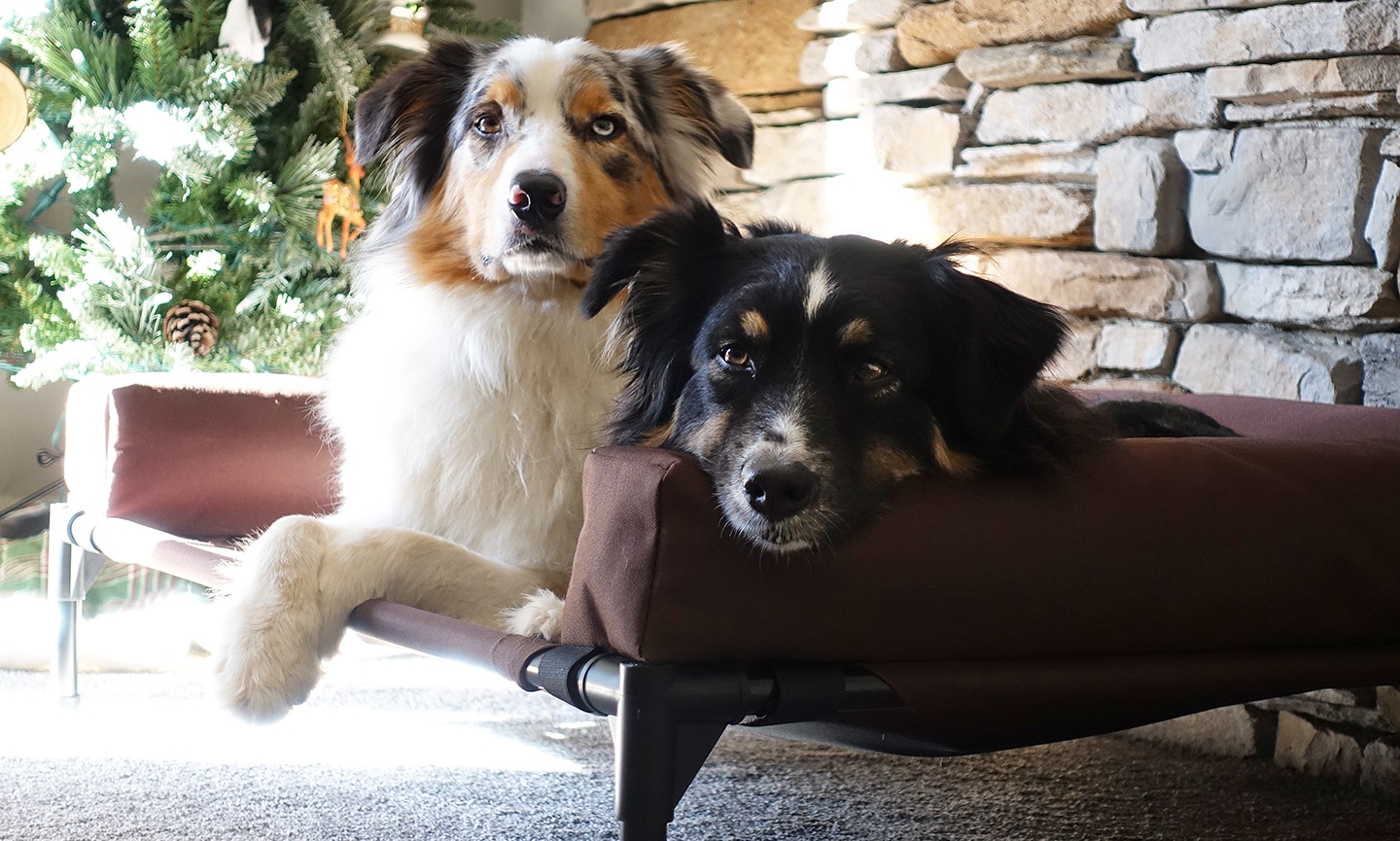
Dog testers Bodie and Willow snuggle up on the best elevated dog bed, K&H Pet Products Original Bolster Pet Cot Elevated Dog Bed. Photo courtesy of Maria Christina Schultz
- Ciara LaVelle: LaVelle is a Chewy editor who has been covering pet care and lifestyle topics for five years. She tested dog beds with Zeno, a Chihuahua–Miniature Pinscher mix who, at 14 years old, is a sweet and spunky senior.

Senior dog Zeno immediately took to the Serta Quilted Orthopedic Bolster Bed, helping the bed earn the Best dog Bed for Older Dogs category. Photo courtesy of Ciara LaVelle
- Kristine Cannon: Cannon is a Chewy editor who has covered pet hard goods and fashion trends for two years. She tested dog beds with Odesza, aka Dez, 3-year-old “super mutt.”
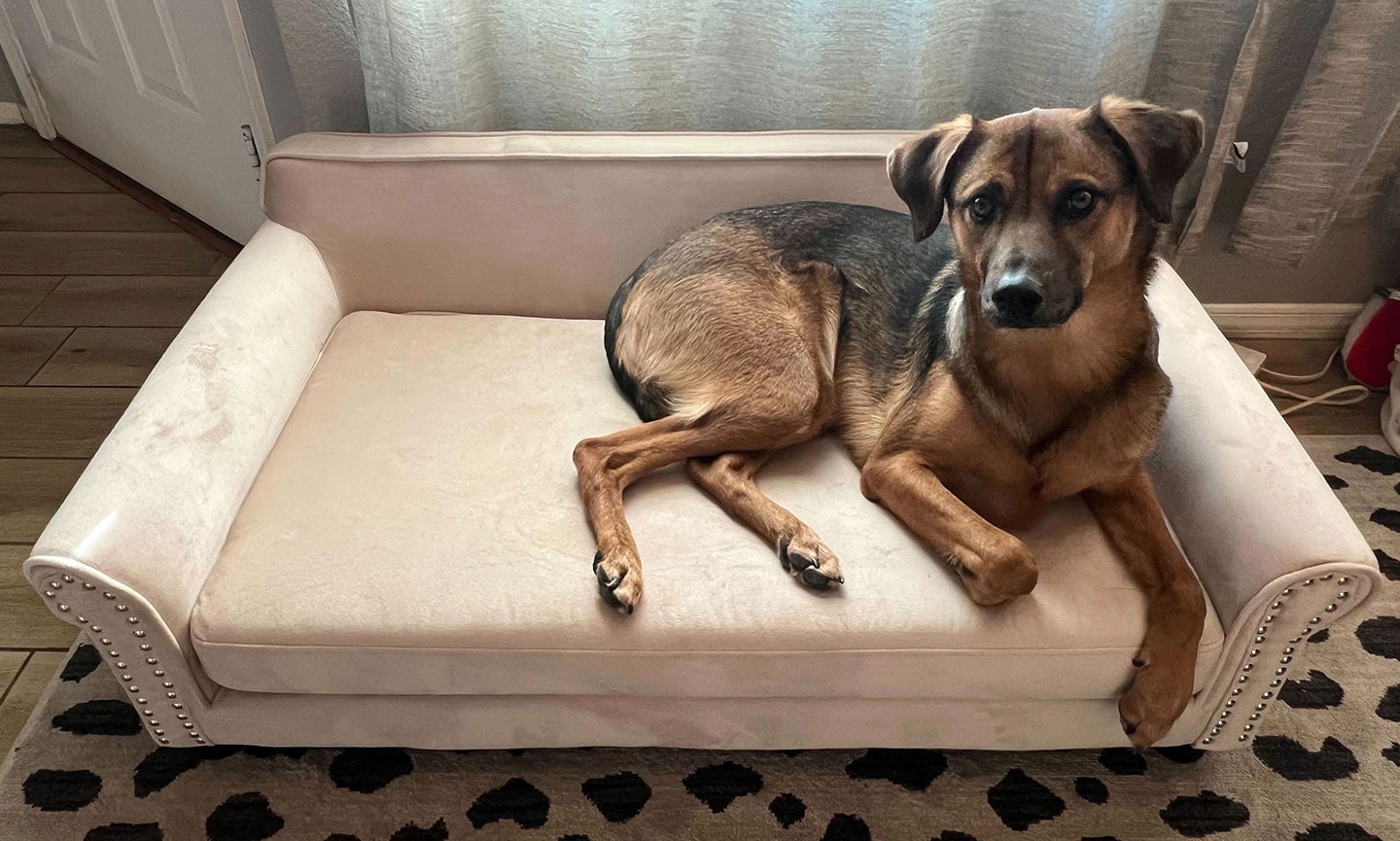
Dog tester Odesza lounges on the best sofa dog bed. Photo courtesy of Kristine Cannon
- Bre South: South is a Chewy editor who has written and edited pet health articles and shopping guides for three years. She tested dog beds with her dog Ezra, a 13-year-old Labrador Retriever mix.

Senior dog Ezra rests on the Frisco Quilted Orthopedic Pillow Lounger Dog Bed. Photo courtesy of Bre South
- Mary Schwager: Schwager is an award-winning journalist in the pet space and longtime dog mom. She tested dog beds with her Labrador Retrievers Macy, 2-years-old, and Jackson, 8 years old.
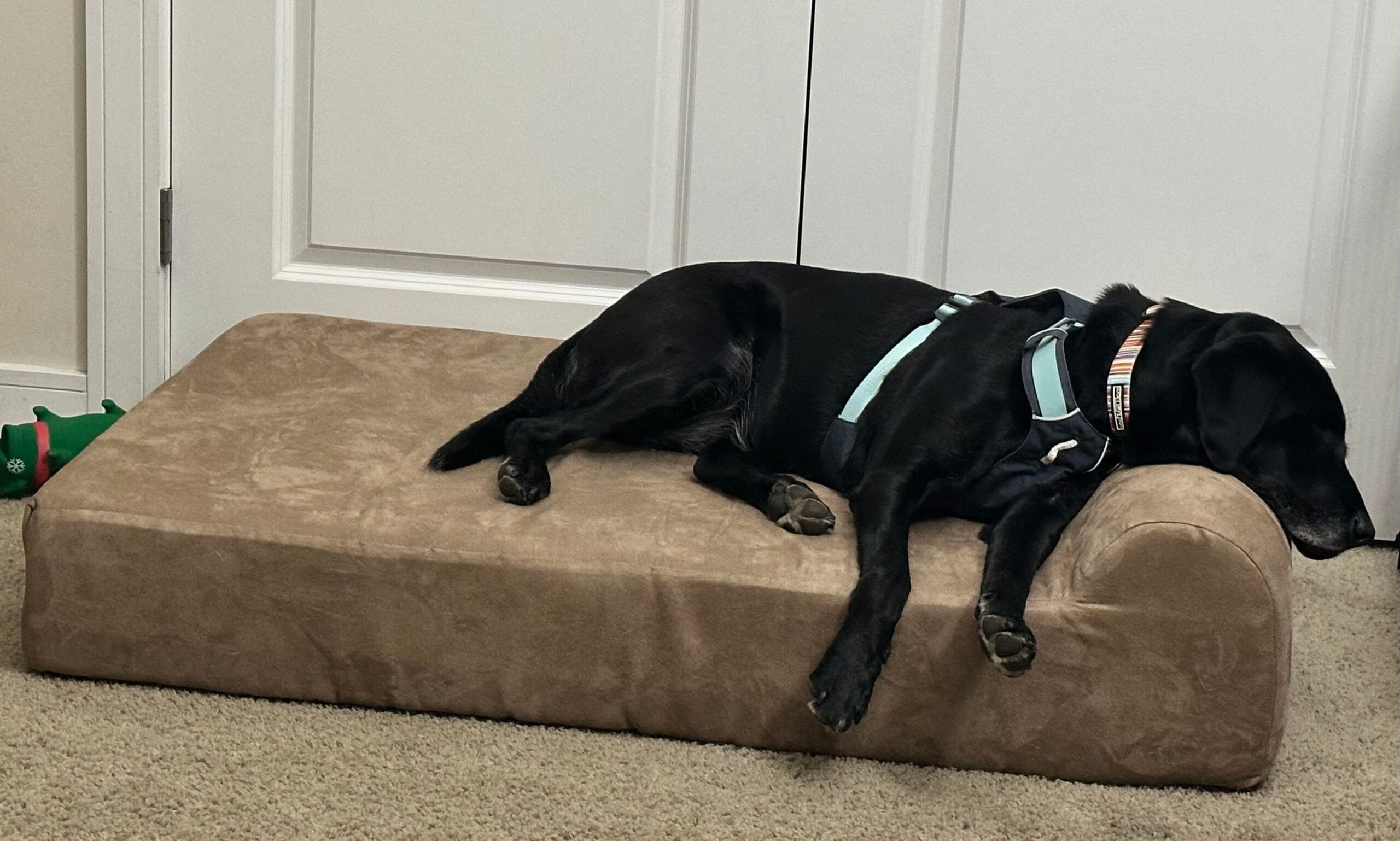
Dog tester Jackson sprawls out on the Big Barker dog bed, our pick for the best dog bed for large dogs. Photo courtesy of Mary Schwager
- Melissa Kauffman: Kauffman is a longtime editor with more than 25 years’ experience in the pet industry. She regularly attends pet product trade shows and has tested hundreds of pet products throughout her career. She tested dog beds with Murphy Brown, 8-year-old Chihuahua-Miniature Pinscher mix, and Liberty Belle, a 3-year-old Cirneco dell’Etna.
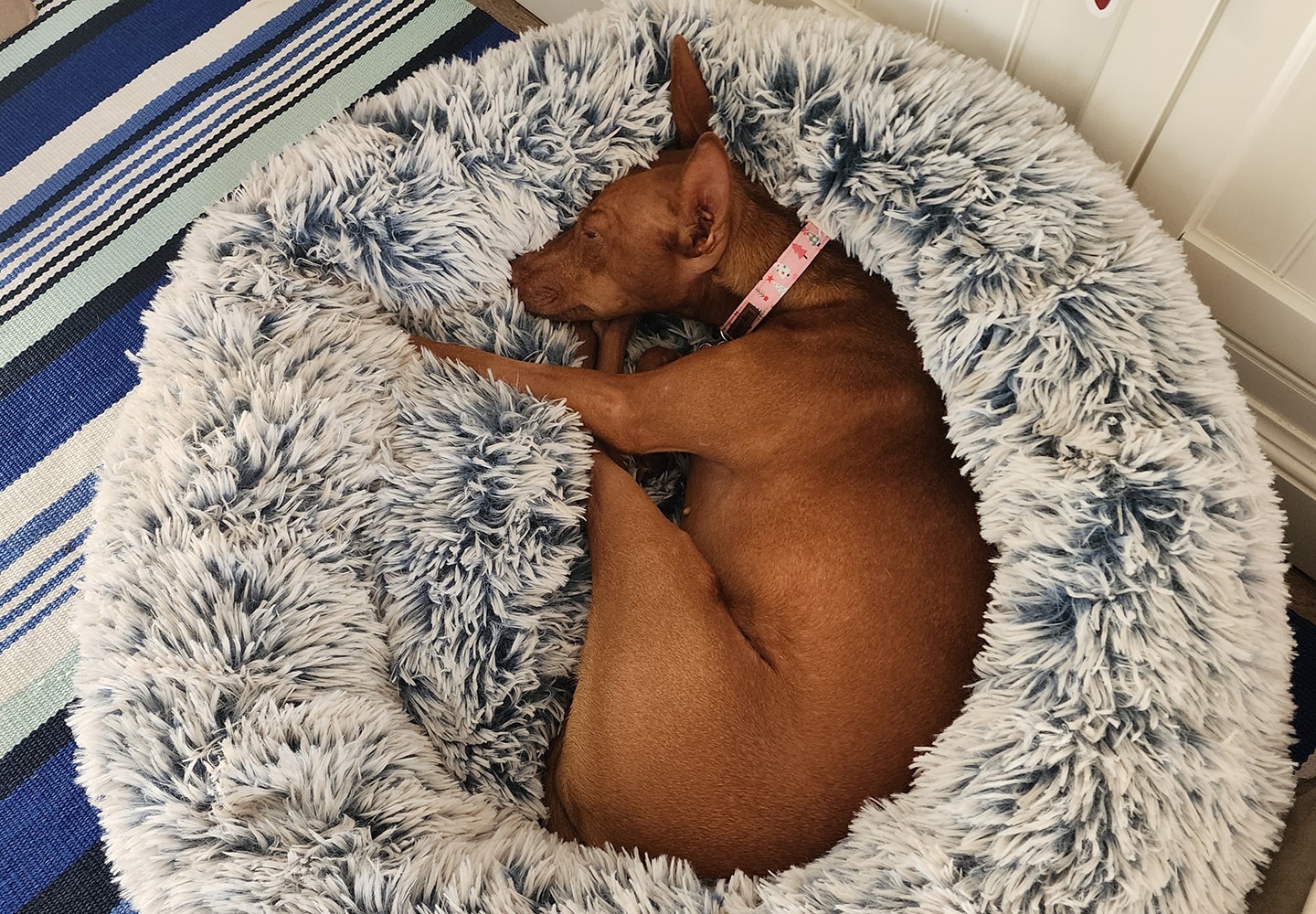
Dog tester Liberty Belle curls up in the best dog bed for small dogs. Photo courtesy of Melissa Kauffman
- Marylou Zarbock: Zarbock is a longtime pet editor. She tested dog beds with her plucky puppy, Cami, a 1.5-year-old Labrador Retriever-Australian Cattle Dog mix.
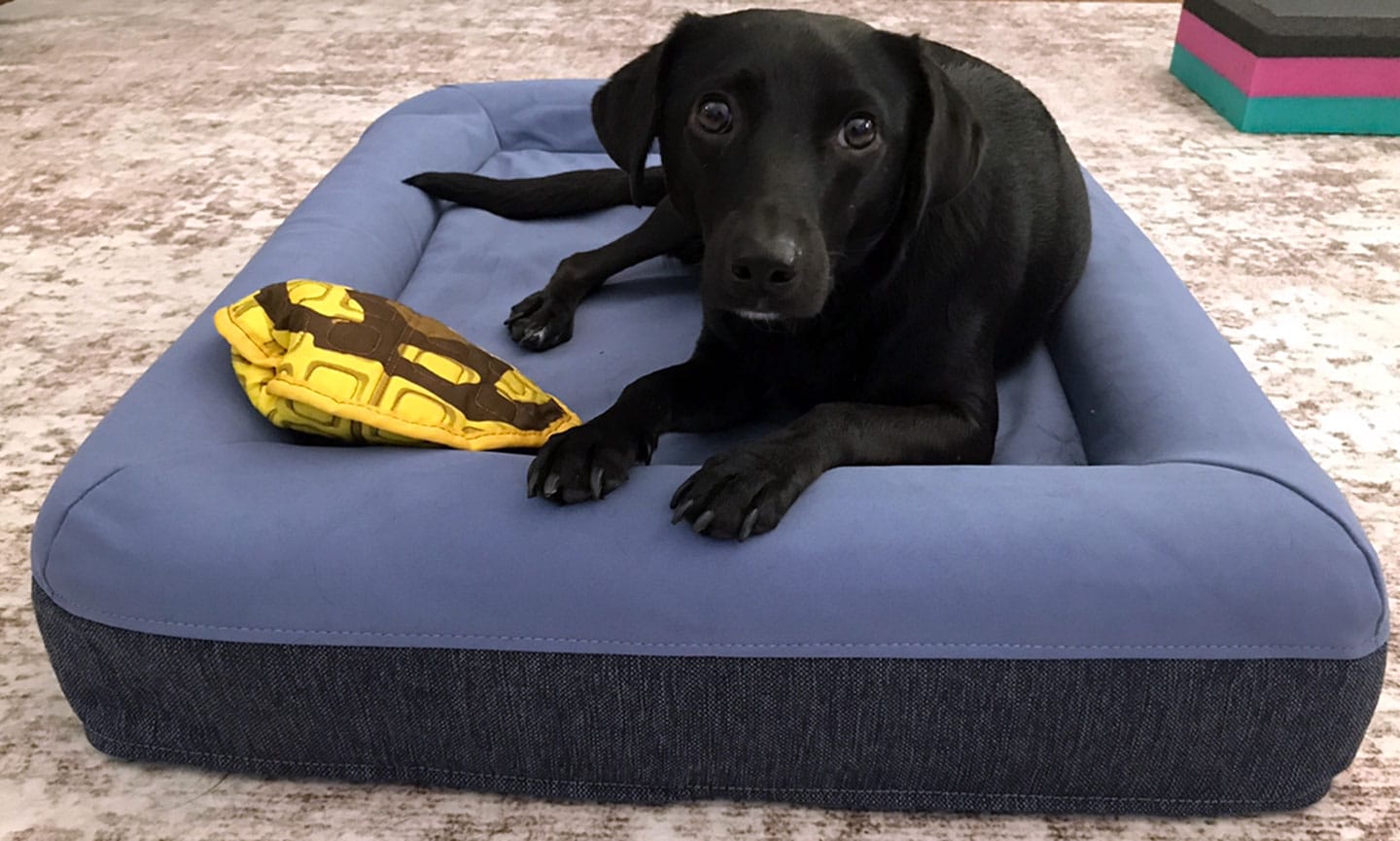
Young pup and curious chewer Cami tests the Casper Bolster Dog Bed. Photo courtesy of Marylou Zarbock
Buying Guide: Types of Dog Beds
There are many different types of dog beds, and some are a mix of different types. This guide is meant to give you an overview of the dog beds available on the market today and what types might be ideal for your dog and lifestyle.
Orthopedic Dog Beds
Orthopedic dog beds typically are made with foam inserts and are designed to provide more support. The type of foam can differ from bed to bed—such as memory foam, egg-crate foam, or cooling-gel foam—and multiple types of foam may be layered in one bed.
Dr. Wooten says these tend to be ideal for big dogs, dogs with joint issues, and very bony dogs.
“You want to look for very thick beds that don’t allow any part of the body to touch the floor,” she says.
Some orthopedic beds tend to trap air and make for warmer sleeping conditions. You may want to consider those that are designed to be breathable or cooling.
Pillow Dog Beds
Pillow dog beds are essentially flat cushions for dogs to rest or sleep on. They can be any shape but are typically rectangular or circular. They can be very thick and plush—even orthopedic—or more mat-like.
Bolster Dog Beds
Bolster dog beds have raised cushions (bolsters) along the back and/or side(s) of the bed.
“Bolsters are good if a dog likes to have something to lay their head on,” says Dr. Wooten. “That is what I see my dog use it for.”
These tend to be shaped like pillow beds but with the addition of bolsters.
Sofa Dog Beds
Sofa dog beds are similar to bolstered dog beds but more closely resemble couches for humans, with a backrest and arms. They often come in modern colors and materials that match today’s human furniture trends.
Elevated Dog Beds
Elevated dog beds run the gamut in terms of style. Some are fancier, pedestal-type beds for indoor use and some resemble cots that can be used outdoors.
No matter the specific style, they all are designed to keep dogs off the cold ground. Dr. Wooten adds that raised dog beds may also be easier for certain dogs to get onto and off of since they are higher off the floor.
Crate Mat
Crate mats are similar to pillow beds but designed to fit inside various-size dog crates. Use them to create a more comfortable den for your dog.
Shop other recommended dog products:
Share:
